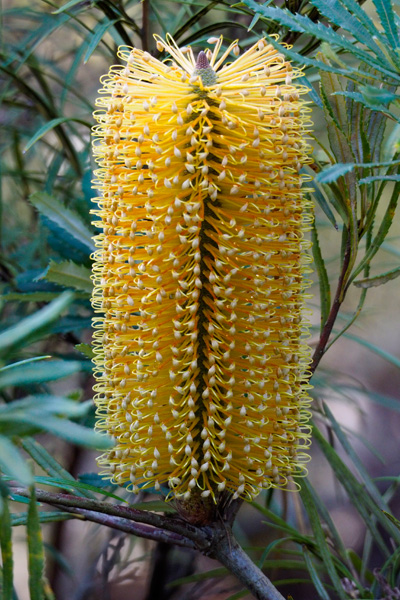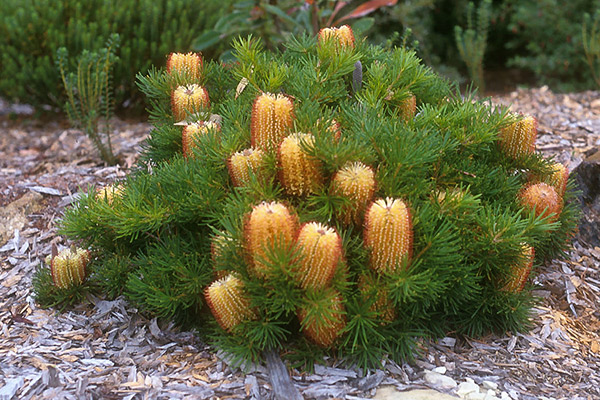General Description:
Banksia spinulosa is a variable species and not all authorities agree on the status of the various forms.
Three varieties are recognised in the Australian Plant Census:
- var. spinulosa – small shrub to 1.5 metres with a lignotuber; leaves generally narrow, linear with recurved margins. Found in several disjunct populations between southern New South Wales and North Queensland.
- var. collina – small shrub to 1.5 metres with a lignotuber; similar to var. spinulosa but with broader and serrated leaves. Found from the central coast of New South Wales to southern Queensland.
- var. cunninghamii – large shrub without a lignotuber; leaves flat with serrated or entire margins. Found in several disjunct populations along the Great Dividing Range from southern Queensland to eastern Victoria. Recognised as a distinct species (B.cunninghamii) in New South Wales.
Two recently described species that were previously regarded as forms of B. spinulosa are:
- B. neoanglica – medium to large shrub, similar to B. spinulosa var. cunninghamii but having a lignotuber. Occurs in the New England plateau in New South Wales though to south-east Queensland.
- B. vincentia – semi-prostrate shrub with a lignotuber known only from 14 individual plants in the Jervis Bay area of New South Wales.
Some intergrading between var. spinulosa and var. collina occurs where the ranges overlap and natural hybrids between B.spinulosa var. spinulosa and B.ericifolia subsp. ericifolia have been recorded in New South Wales.
The flower spikes of all forms are 75-100 mm wide, up to 450 mm long and yellow or orange in colour. This is one of a group of banksias with “hooked” styles projecting from the axis of the flower spike. In B.spinulosa these styles are often deep red or black in colour and this has given rise to the common name of “Hairpin Banksia”, however, the styles may also be orange or yellow. The seeds are enclosed in follicles attached to a woody cone and are generally retained within the cone until burnt.
Despite the specific name, the foliage is not “spiny” in any sense that suggests that it is painful to touch.
Most forms of B.spinulosa have proven to be reliable in gardens in a wide range of districts. A number of select forms are becoming available, for example:
- “Birthday Candles” – 0.5 m high x 1 m across; short, orange spikes with reddish styles.
- “Coastal Cushion” – 0.5 m high x 1.5 m across; yellow spikes with maroon styles.
- “Stumpy Gold” – 0.4 m high x 1.2 m wide; golden flower spikes.
Another popular cultivar, Banksia “Giant Candles” is thought to be a hybrid with B.ericifolia and B.spinulosa as its parents.
Propagation from seed or cuttings is relatively easy. However, named cultivars must only be propagated from cuttings as they do not come true from seed.

A form of Banksia spinulosa
Photo: Brian Walters

Another form of Banksia spinulosa
Photo: Brian Walters

Banksia spinulosa ‘Birthday Candles’
Photo: Brian Walters
Other Native Plant Profiles
 Australian Native Plants Society (Australia)
Australian Native Plants Society (Australia)













